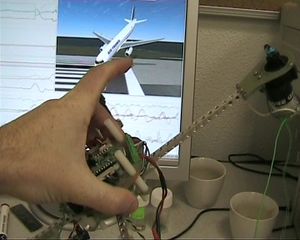Difference between revisions of "Main Page"
| Line 65: | Line 65: | ||
|- | |- | ||
| style="color:#000"| | | style="color:#000"| | ||
[[Image:ahrs2fg.jpg|thumb|left|[http://www.recherche.enac.fr/~poine/video/ahrs2fg.mpeg Download the video]]]Antoine continues to make progress | [[Image:ahrs2fg.jpg|thumb|left|[http://www.recherche.enac.fr/~poine/video/ahrs2fg.mpeg Download the video]]]Antoine continues to make great progress toward the holy grail of 17 state inertial navigation and releases a [http://www.recherche.enac.fr/~poine/video/ahrs2fg.mpeg video] showing the performance of the 7-state [http://en.wikipedia.org/wiki/Kalman_filtering Kalman filtered] IMU providing the attitude-heading reference system [http://en.wikipedia.org/wiki/Attitude_and_Heading_Reference_Systems (AHRS)] on his quadrotor. Note how much coffee was consumed in preparation for this video. More info on the IMU is available on the [[Sensors|sensors]] page. Also, be sure to admire the [http://cvs.savannah.gnu.org/viewcvs/paparazzi/paparazzi3/hw/sensors/ schematics] and [http://cvs.savannah.gnu.org/viewcvs/paparazzi/paparazzi3/sw/airborne/ source code]! | ||
|- | |- | ||
Revision as of 13:31, 7 December 2006
Welcome To Paparazzi | ||||||||||||||||
|
| |||||||||||||||

